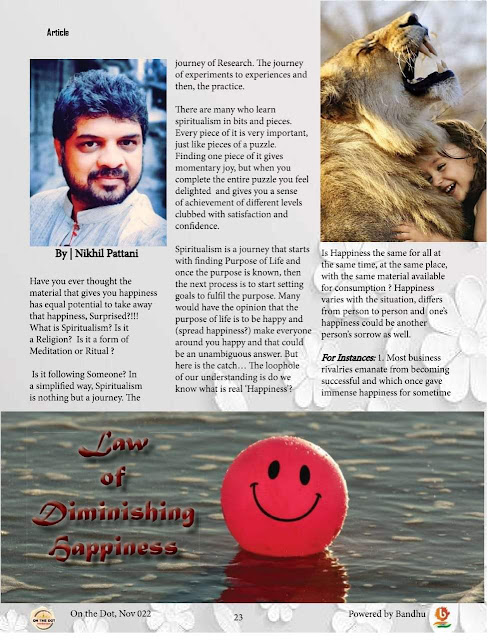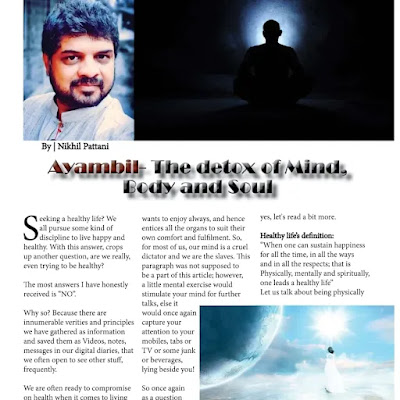Law of Diminishing Happiness
Law of Diminishing Happiness
By | Nikhil Pattani
It was published in On the dot ezine
This article was also published in On the dot ezine link added
Have you ever thought the material that gives you happiness has equal potential to take away that happiness, Surprised?!!!
What is Spiritualism? Is it a Religion? Is it a form of Meditation or Ritual ? Is it following Someone? In a simplified way, Spiritualism is nothing but a journey. The journey of Research. The journey of experiments to experiences and then, the practice.
There are many who learn spiritualism in bits and pieces. Every piece of it is very important, just like pieces of a puzzle. Finding one piece of it gives momentary joy, but when you complete the entire puzzle you feel delighted and gives you a sense of achievement of different levels clubbed with satisfaction and confidence.
Spiritualism is a journey that starts with finding Purpose of Life and once the purpose is known, then the next process is to start setting goals to fulfil the purpose. Many would have the opinion that the purpose of life is to be happy and (spread happiness?) make everyone around you happy and that could be an unambiguous answer. But here is the catch… The loophole of our understanding is do we know what is real ‘Happiness’? Is Happiness the same for all at the same time, at the same place, with the same material available for consumption ? Happiness varies with the situation, differs from person to person and one’s happiness could be another person’s sorrow as well.
For Instances: Most business rivalries emanate from becoming successful and which once gave immense happiness for sometime in the past may now be a reason for stress.
One must really thrive to know something beyond stress. Fear, disappointments, frustrations, irritation, anger, failures, setbacks, delays, suspicions, trauma, pressure, regrets and many such experiences of severity in the journey of achieving success, which gradually started with the aim to earn happiness forever. With the lapse of time we forget, what exactly did we start the journey for and in pursuit of that happiness a routine sets in for earning stress, fears, and failures etc. and at the end whatever is earned is misunderstood as “Happiness”.
If this is not happiness, then what is happiness?
There are two types of happiness:
Temporary Happiness (Kshanik Sukh)
Permanent Happiness (Shaswat Sukh)
Temporary Happiness:
Most human beings struggle getting a little happiness at the end of all the hardships they have endured. Temporary happiness as the name suggests means it doesn’t last longer as expected, and sometimes it just gives a bit of relaxation, and it is no more. In other words, temporary happiness changes every minute when something changes in life or when a situation changes. Temporary happiness comes from birth of newborn; money earned; purchase and accumulation of possessions (house, vehicle, jewellery, land, ownerships, pets, business), Marriage, Friendships, helping others, social activities and gatherings like, picnics, trips, travels, parties, dance, music, arts, fitness, show business, consuming alcohol, smoking, , Achievements, Awards, Rewards, some mental satisfaction etc., there is a long, never ending list of sources and reasons for this temporary happiness.
As you may know the famous law of economics- The Law of Diminishing marginal utility, states that with every consumption of additional similar units, it may start giving dissatisfaction. This simple law teaches us lessons of life.
For example, let us assume Gulab Jamun (Indian Sweet dipped in Sugar syrup) is your favourite dessert, and you haven’t tasted it for a while. Imagine the level of satisfaction the first Gulab jamun gives you … Imagine the words that may come out of your mouth after consuming the mouth watering gulab jamun. There are still few left in the plate, and your craving urges you to go for seconds and that gives you additional satisfaction and you are very very happy, you pick up the third, and the level of satisfaction and happiness over taste increases steeply, you consume 4th and 5th now you still can have it for the sake of it. The 7th and 8th were given to you forcibly, but now your tummy is full, your tongue craves for something different, the liking for that sweet may decline or you may not be able to bear or dread the thought of having to eat more sweets. Imagine with such difficulty, you are shown 10th and 11th Gulab jamun, would you even think good about it? This will start giving you dissatisfaction and may cause anger should you be forced to eat them. Now you would want a different taste, as Gulab Jamun has already taken a toll on your taste and appetite too, hence the Same Gulab jamun, which gave you tremendous happiness in the first instance is now giving you trauma and ill feeling.
Similarly, let’s see another example of Mr. Smart who made a decent living and started earning money for buying food, clothing and shelter for himself and his family. The family was very poor and barely met the ends to survive. Gradually, Mr. Smart started earning better, bought a small house, bought some new clothes and healthy food. The family couldn’t be more happier with the changes they had in their life. The family was very supportive of Mr. Smart. however with the rise in his income so did increase the demands and needs of his family. With the enumerable demands and rising expenses, they could barely save anything from the increments, however their standard of living was improving (Again a matter of happiness!!). This happiness soon withered. Now the house seemed smaller and (inhabitable), the furniture seemed outdated, the clothes needed a different style, the food required fancy plates and their taste buds also changed from being simple to extraordinary all the time. In a pace the expenses kept increasing whereas, the income was not at par with the increase. The more money Mr. Smart earned to satisfy his lifestyle and his family’s needs, more demands made his life miserable. There were disagreements, quarrels, debts, stress, ambiguities, theft, health issues etc… But life goes on without any realisation that all these efforts were to remain happy forever in the first place.
In essence, any material on this earth can never give you the happiness that can last forever. Any material we own today is going to change its form, status, value and meaning sooner or later and hence the happiness coming from those materials will also be as temporary as the material itself.
Many Saints, Preachers, Teachers, Scholars from the past, Liberated souls like Shri Ram, Mahaveer Swami, Gautam Buddha, Jesus Christ and many more taught us to refrain from the attachment of any materials, rather adopt simplicity and embrace transparency.
The second type of Happiness – Permanent Happiness (Shaswat Sukh)
The happiness, once achieved, never goes back despite the passing of a billion years into the future and also there will be no sign of any wear and tear happening to the happiness you possess.
How is it possible?
All human beings fear change, especially the physical changes in body, height, complexion, skin, along with the change in age. But no one thinks about why we have this body? Am I born into this family? Who was I before I was born? Why am I born into uncertainties or complications? The answers to this are your Karmas, i.e., Karma of infinite past life and Karma of this life. Karma will give back everything with interest to your body, and also get attached to your soul. Karma is the King of all deeds and is universal, it creates a situation to pay back everything one desires or deserves.
When you reach a state where the Karma account remains zero with nothing to reciprocate or offset, your birth cycle stops to attain Nirvana, the complete liberation from the vicious cycles of births and deaths.
The soul will remain in Anant Pradesh forever with no connection to the material world. No Birth so no fear of death. Since no birth no worries, since there is no birth there are no means and modes of material required at all. This is a state where the Soul can see and becomes aware of everything, but no attachment, hence no detachment. This is known as MOKSHA or Shivpad, or Nirvana or Sacchidanand Swaroop, or the state of Sahajanand (Natural Happiness). The Soul becomes Niranjan ( Needs no entertainment from outside); Nirakar (NO shape is now required); Nirlep (No cladding is required anymore); Avyaabadh Swarop ( Has no limits or restrictions) and much more.
Many of our readers may feel, whether the above is even possible ?
Yes it is possible., The ways of achieving such liberation are shown by the ones who walked through this path . The 24 Tirthankaras of Jains showed the complete path of Moksh. Buddha Talks about Liberation – Mahapari nirvana, most Saints showed the path of Moksha through simplicity, lived a minimalistic life and embraced austerity to the core.
The Entire new topic on, ‘The path of liberation and Complete happiness’ will be discussed in the next edition…….
*The writer is a Real Estate Expert with more than 27 Years of work experience. A Jain by religion, he is an Artist by heart. With his vivid experience in diverse fields Nikhil steers to provide professional real estate, religious, philosophical guidance which is not only fruitful but helps spreading positivity.*






Comments
Post a Comment